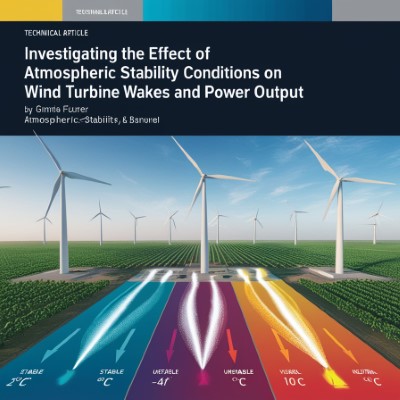Wind energy is a rapidly growing sector in the quest for sustainable and renewable energy sources. However, optimizing the performance and efficiency of wind turbines requires a deep understanding of various environmental factors that influence their operation. One critical factor is atmospheric stability, which significantly affects wind turbine wakes and, consequently, power output. This article explores the relationship between atmospheric stability conditions, wind turbine wakes, and the resulting impact on power generation.
Introduction to Atmospheric Stability
Atmospheric stability refers to the resistance of the atmosphere to vertical motion. It is primarily determined by temperature gradients and can be categorized into three main types:
- Stable Atmosphere: Characterized by a temperature inversion where the temperature increases with altitude, suppressing vertical air movement.
- Unstable Atmosphere: Occurs when the temperature decreases rapidly with altitude, promoting vertical air motion and turbulence.
- Neutral Atmosphere: A condition where the temperature gradient does not significantly influence vertical air movement, often occurring during overcast days with moderate wind speeds.
These stability conditions influence the behavior of wind flows and turbulence, which in turn affect wind turbine wakes.
Wind Turbine Wakes and Atmospheric Stability
Wake Formation and Characteristics
When wind passes through a wind turbine, the rotor blades extract kinetic energy from the wind, creating a region of reduced wind speed and increased turbulence downwind of the turbine. This region is known as the wake. The wake’s characteristics, such as its length, width, and intensity, are influenced by atmospheric stability:
- Stable Conditions: In stable atmospheres, vertical air movement is suppressed, resulting in a narrower and longer wake with reduced mixing with the surrounding air. This can lead to prolonged regions of low wind speed downwind.
- Unstable Conditions: Unstable atmospheres promote vertical mixing, causing wakes to dissipate more quickly. The wake is wider and shorter, with faster recovery of wind speeds.
- Neutral Conditions: Wakes under neutral conditions exhibit characteristics between those of stable and unstable atmospheres, with moderate wake length and recovery rates.
Impact on Power Output
The interaction of turbine wakes with downstream turbines in a wind farm can significantly affect power output. The reduced wind speeds in the wake regions lead to lower energy capture by downstream turbines, known as wake losses. Atmospheric stability plays a crucial role in determining the extent of these wake losses:
- Stable Atmosphere: The persistent and elongated wakes result in substantial wake losses, reducing the power output of downstream turbines significantly. The cumulative effect can lead to decreased overall efficiency of the wind farm.
- Unstable Atmosphere: Faster wake dissipation and recovery of wind speeds mitigate wake losses, enhancing the power output of downstream turbines. The overall efficiency of the wind farm is higher compared to stable conditions.
- Neutral Atmosphere: Wake losses are moderate, and the power output of downstream turbines is affected to a lesser extent than in stable conditions but more than in unstable conditions.
Case Study: Quantifying the Effects
To quantify the effects of atmospheric stability on wind turbine wakes and power output, a comprehensive field study or computational fluid dynamics (CFD) simulations can be conducted. Here’s an outline of a potential study approach:
Methodology
- Data Collection: Gather meteorological data (wind speed, direction, temperature profiles) and power output data from a wind farm over an extended period.
- Stability Classification: Classify the atmospheric stability conditions based on temperature gradient and wind speed data.
- Wake Analysis: Use Lidar or other remote sensing technologies to measure wake characteristics under different stability conditions.
- CFD Simulations: Perform CFD simulations to model wake behavior and power output for varying stability conditions.
Results
The study would aim to reveal trends such as:
- The relationship between atmospheric stability and wake length, width, and turbulence intensity.
- Quantitative estimates of wake losses and power output variations under different stability conditions.
- Recommendations for optimizing turbine spacing and yaw control based on stability conditions.
Conclusion
Understanding the effect of atmospheric stability on wind turbine wakes and power output is crucial for optimizing wind farm performance. Stable atmospheric conditions tend to exacerbate wake losses, while unstable conditions promote faster wake recovery and higher power output. By incorporating stability considerations into wind farm design and operation, operators can enhance energy capture and improve the overall efficiency of wind energy projects.
Future research and technological advancements, such as real-time monitoring and adaptive control strategies, will further mitigate the adverse effects of atmospheric stability on wind turbine performance, contributing to more reliable and efficient renewable energy production.

